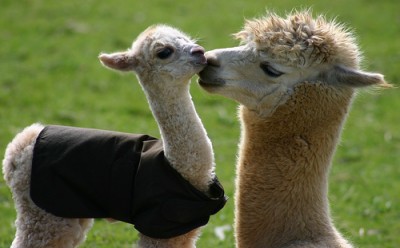
Image source: supercuter
Llamas belong to the family of animals that include domesticated alpacas and wild guanacos and vicunas, which both live in herds in South America. Known as modified ruminants, llamas weigh upwards of 300 to 400 pounds and can stand up to 6 feet tall when mature. They have very soft pads on the bottom of their feet, which means they have very little impact on the environment.
Not only are they super cute, but llamas are also very smart. They learn quickly with few repetitions and are willing to follow instructions when necessary.
Llamas make a great addition to any homestead and are quickly gaining popularity for a number of reasons. Every two years, these wooly creatures can be shorn for their fiber that is soft and lanolin-free. They are very sturdy pack animals and make a great “watch dog.” In fact, an adult llama can carry up to one-third of its weight over rugged terrain and at high altitudes. Llamas are also very effective at protecting herds of sheep, geese and goats from coyotes and other predators. Some people even use llamas to pull carts.
Although not popular in the United States, in some places, such as South America, these animals are used for food.
Selecting a Llama
Like people, all llamas are different; they have unique personalities. It is best to know what task you want your llama for before choosing the best one for you. Some llamas are great in packs, and some are good for show or guarding.
Easy step-by-step instructions on raising livestock and ‘Back To Basics’ skills… [1]
Here are just a few of the things to look for when selecting your llama:
Guard Llamas
Most guard llamas are geldings, but you may also come across a few females who could also get the job done. Llama guards are selected by the time they are two; this is usually when they start to show guarding characteristics. Look for llamas that are alert, healthy and seem watchful. You will also want one that bonds well with a herd but remains somewhat aloof.
Choosing a Driving Llama
Driving llamas should have an easy going and willing personality and not mind being approached by a great number of people. Most llamas will begin ground training at 18-24 months of age. Traditionally, male llamas are used for driving, partly because there are always more males than females and also because females are reserved for bearing and raising young. There is no reason to think that females would not also be excellent drivers if used. Most llamas reach their driving prime by the time they are five or six years of age.
Choosing a Pack Llama
Llamas’ intelligence and agility make them wonderful pack animals and fun companions. For more than 4,000 years, llamas have been used to transport goods through the rugged terrain of the Andean mountains in South America. Today, llamas are the newest pack animals to be used in North America. Male llamas, in good physical condition, both intact and gelded, make excellent pack animals, although gelded llamas generally get along better with a herd. Healthy, well-trained female llamas also make excellent pack animals.
Story continues below video
Once a llama has learned to stand and be caught and can be haltered easily, it can start to learn how to pack. Most llamas will take to the ground training well and learn quickly. When llamas are around two to three years of age they can carry a lightweight load of no more than 40 pounds, including their saddle.
A seasoned pack llama can cover up to 15 miles a day on well-graded trails. Don’t push young llamas this far, however. Be sure to get well-fitting equipment. This will make it easier for your llama. You will also need a picket line for staking the llama when you stop or camp out.
Choosing a Pet Llama
Some people enjoy having a llama around as a pet; they also make excellent companions for other herd animals. Choose personable and willing llamas for pets that are interested in you and bond well with other animals. Llamas will help keep your grass trimmed and are a lot of fun to show at events such as those offered through 4-H.
Tips for Choosing and Keeping Llamas
- Llamas benefit from a three-sided shelter with a roof to block wind and rain or a number of trees which also offer some protection. You may also benefit from a catch pen that is 12-by-12 feet.
- Llamas are generally priced according to their ability, bloodlines, showing/fiber quality and training. Prices start around $250 and go up to even several thousand. Do not purchase an intact male unless you have a lot of experience. Be careful choosing llamas that are really cheap; they can have severe behavioral problems. It is recommended to purchase two llamas of the same sex unless you have other animals for the llama to bond with such as sheep, alpacas, goats or horses.
- Llamas are grazing animals and will enjoy grass, blackberry leaves, fir boughs and other leaves. You can give hay if there is nothing for them to eat and a little grain as a treat. They will need mineral supplements and fresh water as well. Once a year you can shear them and cut nails. Most people deworm several times each year.
As with any animal, be sure to do your homework before getting started with llamas. The more you know upfront, the better prepared you will be to handle, train and enjoy them.
Have you ever owned llamas? What tips do you have? Share them in the section below:
Sign up for Off The Grid News’ weekly email and stay informed about the issues important to you [2]
